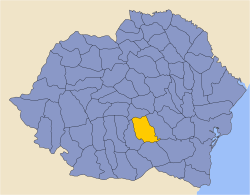|
Prahova County
Prahova County (Romanian pronunciation: [ˈprahova]) is a county (județ) of Romania, in the historical region Muntenia, with the capital city at Ploiești. DemographicsIn 2011, it had a population of 762,886 and the population density was 161/km2. It is Romania's third most populated county (after the Municipality of Bucharest and Iași County),[3] having a population density double that of the country's mean.
The county received an inflow of population who have moved here due to the industrial development. GeographyThis county has a total area of 4,716 km2. The relief is split in approximately equal parts between the mountains, the hills and the plain. In the North side there are mountains from the southern end of the Eastern Carpathians - the Curvature Carpathians group; and the Bucegi Mountains the Eastern end of the Southern Carpathians group. The two groups are separated by the Prahova River Valley. The south side of the county is a plain, on the North West side of the Romanian Plain. The main river is the eponymous Prahova River. It flows from the mountains, through the Prahova Valley collecting many other rivers - the Doftana River, the Teleajen River and others. Neighbours
EconomyThe area contains the main oil reserves in Romania,[citation needed] with a longstanding tradition in extracting and refining the oil. The county is heavily industrialised, with over 115,000 residents working in industrial environments. It contributes to over 8% of the country's industrial production.[citation needed] Some of the biggest international corporations like Coca-Cola, Unilever, InBev, Johnson Controls, Cameron, Weatherford, Michelin, Timken and others have invested heavily in the recent years.[citation needed] The predominant industries in the county are:
Agriculture is also developed — in the southern part mainly extensive agriculture and the hills area is well suited for wines and fruit orchards. In total it realises about 3% of the country's agricultural production. TourismThe Prahova Valley is one of the areas with the highest tourist potential in the country having one of the best tourism facilities in Romania. The main tourist destinations are:
PoliticsThe Prahova County Council, renewed at the 2020 local elections, consists of 36 counsellors, with the following party composition:[6]
Administrative divisionsPrahova County has 2 municipalities, 12 towns and 90 communes  Municipalities Towns Communes
Historical county
Historically, the county was located in the south central part of Greater Romania, in the central part of the historical region of Muntenia. Its capital was Ploiești (then spelt Ploești). The interwar county territory comprised a large part of the current Prahova County, except the town of Mizil and several nearby villages that were then in Buzău County. In addition to the current county's territory, the interwar county contained several communes in its western part (including Dărmănești, I.L. Caragiale, and Moreni), currently in Dâmbovița County, and some territory northwest of Predeal, now in Brașov County. Administration The county was originally divided into seven administrative districts (plăși):[7]
Subsequently, the county established three more districts:
PopulationAccording to the 1930 census data, the county population was 477,750 inhabitants, ethnically divided as follows: 95.0% Romanians, 1.5% Gypsies, 0.9% Jews, 0.8% Hungarians, 0.7% Germans, as well as other minorities.[8] From the religious point of view, the population was 96.0% Eastern Orthodox, 1.2% Roman Catholic, 1.0% Jewish, 0.6% Lutherans, 0.5% Greek Catholic, as well as other minorities.[9] Urban populationIn 1930, the county's urban population was 105,098 inhabitants, comprising 88.8% Romanians, 3.5% Jews, 1.9% Hungarians, 1.7% Germans, 1.4% Romanies, as well as other minorities.[8] From the religious point of view, the urban population was composed of 89.2% Eastern Orthodox, 3.6% Jewish, 3.3% Roman Catholic, 1.5% Lutheran, 1.3% Greek Catholic, 0.6% Reformed, as well as other minorities.[9] See alsoReferencesWikimedia Commons has media related to Prahova County.
External links |
|||||||||||||||||||||||||||||||||||||||||||||||||||||||||||||||||||||||||||||||||||||||||||||||||||||||||||||||||||||||||||||||||||||||||||||||||||||||||||||||||||||||||||||||||||||||||||||||||||||||||||||||||||||










